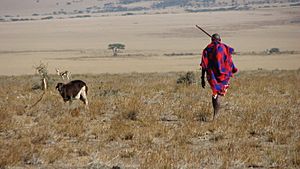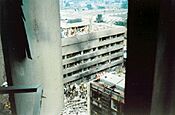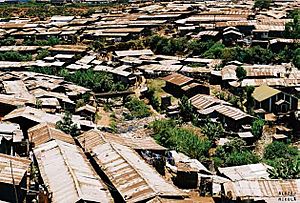History of Nairobi facts for kids
Nairobi's history began in 1899. That's when a railway station was built in a wet, swampy area in Africa. This land was home to the Maasai, who raised animals, and the Akamba and Kikuyu people, who farmed. These groups were moved away by the British. The railway area and buildings quickly grew into a large city. Today, Nairobi is the biggest city in Kenya and its capital. The name Nairobi comes from the Maasai words Enkare Nyirobi, meaning 'the place of cool waters'. But many people also call Nairobi the "Green City in the Sun."
Contents
Early Days of Nairobi

The land where Nairobi now stands was once a swamp. It was used by the Maasai, Akamba, and Kikuyu people. The British decided to build a railroad from Mombasa to Kisumu. This was part of the British East Africa protectorate. The goal was to open up East Africa for trade and encourage British people to settle there. The Maasai were forced to leave their land so white ranchers could use it.
Work on the railway started in 1894. In 1899, the British built a railway camp and supply depot in the Maasai area. This camp soon became the main office for the Uganda Railway. A town grew around it. It was named after a watering hole called Ewaso Nyirobi in Maasai, which means 'cool waters'.
Nairobi was chosen because it was in the middle of the railway line between Mombasa and Kampala. It also had many rivers nearby for water. The area was high up, making it cool and comfortable to live in. At 1661 meters above sea level, it was also too cool for mosquitoes that carry malaria.
In the early 1900s, a serious disease called the plague broke out. The original town was then burned down to stop the disease. After this, the town was completely rebuilt. By 1905, Nairobi was a busy business center. It took over from Mombasa as the capital of British East Africa. The city grew because of its government jobs and tourism. At first, tourism meant British people coming for big game hunting. The British colonial government built large hotels for these tourists and hunters.
Nairobi kept growing under British rule. Many British people moved to the city's suburbs. This constant growth made the Maasai and Kikuyu angry. They felt the city was taking over their land. In 1919, the British officially made Nairobi a municipality.
In 1926, a man named E.A.T. Dutton visited Nairobi. He saw the city's progress and big plans. He imagined a future city with paved roads, beautiful streets, parks, churches, museums, and theaters. He believed Nairobi would become a beautiful city. But he also noted that much work was needed before these plans would be finished.
Growing Tensions and Independence
In 1915, the British made laws that only allowed white people to own land. They also brought in high taxes and low wages for Black Africans. Africans were forced to carry identification cards. In 1921, Harry Thuku started the Young Kikuyu Association. He began to organize protests against the British.
On March 14, 1922, Harry Thuku was arrested. This led to a big strike in Nairobi. Thousands of Africans protested. The British government responded by shooting many protesters. This event shocked people around the world. Harry Thuku was sent away to a distant place. But this was just the start of more unrest.
The protests led to a way of planning the town that kept African people separate. This was a way to control the African population in Nairobi.
After World War II, the problems grew into the Mau Mau Uprising. Jomo Kenyatta, who would become Kenya's first president, moved to Nairobi from a small village. He joined the Kikuyu Central Association and became its general secretary. This led to him becoming Kenya's first prime minister and then its first president. The local people put a lot of pressure on the British. This led to Kenya becoming an independent country in 1963. Nairobi became the capital of the new republic.
Because the area around Nairobi was popular for British big game hunters, the Nairobi National Park was created in 1946. This was done to protect the animals. It was the first national park in East Africa. Even today, it is special because it is the only wildlife park that borders a capital city in the world.
Nairobi After Independence
After Kenya became independent, Nairobi grew very quickly. This fast growth put a lot of strain on the city's services, like electricity and water. Power cuts and water shortages were common. However, in recent years, better city planning has helped to fix some of these issues.
In 1975, Nairobi hosted the 5th Assembly of the World Council of Churches.
On August 7, 1998, the U.S. embassy in Nairobi was bombed by Al-Qaida. This was part of a series of U.S. embassy bombings. Many people were killed and injured in the embassy and the surrounding area. The embassy was completely destroyed. Many other buildings were badly damaged. One seven-story building collapsed.
The growth of Nairobi has also made it harder for the government to protect lands like the Nairobi National Park. New homes for the growing human population are being built on lands that animals have traditionally used for migration.
After the Kenyan presidential election, 2007, there was some serious violence in Nairobi. In one area called Mathare, groups burned many homes.
On September 21, 2013, a shooting happened at the luxurious Westgate shopping mall in Nairobi's Westlands neighborhood. Many people lost their lives. A group called Al-Shabaab said they were responsible for the attacks.
See also
- Timeline of Nairobi history
- History of Kenya



